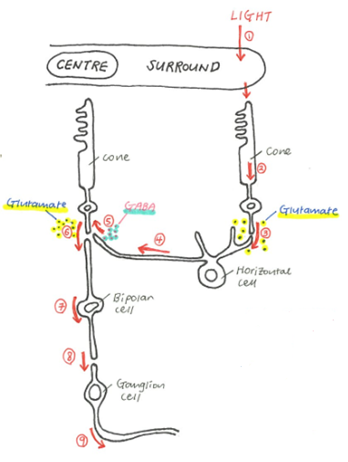Colour vision
Figure 1: Visual spectrum at different wavelengths. Humans can only perceive 390nm to 700nm on the visual spectrum.
Source: Genoa College of Fine Arts (2014) Chromatology, Available at: http://www.accademialigustica.it/blog/?page_id=58 (Accessed: 3rd June 2014).
- Colour of object is determined by which wavelengths of light is absorbed or reflected.
- White objects = reflect all wavelengths
- Black objects = absorb all wavelengths
- Red object = absorbs more of the shortwave part of the spectrum & long wave light is reflected
- Different type of cones with maximal sensitivity to light of different wavelengths = basis for colour vision
- Birds & lower vertebrates: at least 3 different types of cones = EXCELLENT colour vision
- Mammals (including all domestic animals): 2 types of cones
- Exception: some primates & humans
- Few species: 1 type
- Primates (including human) : developed 3rd type
- 3 types of cones in primates absorb light most efficiently in blue, green-yellow & orange-red parts of the spectrum
- Blue, geen and red cones
- Overlap between wavelengths absorbed by these 3 cones
- Human brain can discriminate between colours
- ie. 560nm: green & red stimulated equally & blue not affected = yellow
- Colour vision based on
- 3 types of cones = Trichromatic
- 2 types of cones = Dichromatic

Figure 2: Three different types of cones found in trichromatic primates, including humans, have different sensitivities to light of different wavelengths. Thus forming the basis for colour vision in these primates.
Source: Sjaastad O.V., Sand O. and Hove K. (2010) Physiology of domestic animals, 2nd edn., Oslo: Scandinavian Veterinary Press.
Fun facts
- In vertebrates, it has been found that animals must discriminate between stimuli before expressing preference for a colour
- e.g. Frogs forced to choose between two adjacent, illuminated panels. They select the bluer one
- Fish have good colour vision
- Fish retinas contain multiple classes of photopigments for colour vision
- e.g Gold fish absorbency spectrum shifted to longer wavelengths
- Primate colour vision spectral range: 400-700nm.
- Diurnal birds have a larger range than primates!
- Red-green colour blindness
- Caused by absence of long or middle wavelength-sensitive visual photopigments (specifically cones)
- Been proven that addition of a third cone class can produce improved trichromatic vision in primates
References
- Genoa College of Fine Arts (2014) Chromatology, Available at: http://www.accademialigustica.it/blog/?page_id=58 (Accessed: 3rd June 2014).
- Jacobs G. H. (1983) 'Colour vision in animals', Endeavour, 7(3), pp. 137-140.
- Mancuso K., Hausworth W.W., Li Q., Connor T.B., Kuchenbecker J.A., Mauck M.C., Neitz J. and Neitz M. (2009) ' Gene therapy for red-green colour blindness in adult primates', Nature, 461, pp. 784-787.
- Sjaastad O.V., Sand O. and Hove K. (2010) Physiology of domestic animals, 2nd edn., Oslo: Scandinavian Veterinary Press.















